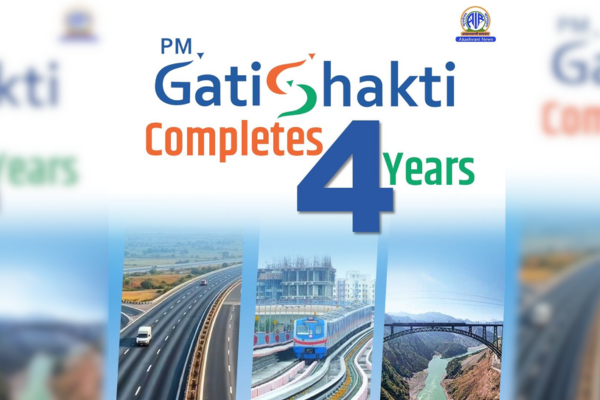PM GatiShakti National Master Plan Completes Four Years

PM GatiShakti National Master Plan Completes Four Years: A Transformative Infrastructure Framework
Introduction
The PM GatiShakti National Master Plan (NMP), launched by Prime Minister Narendra Modi on 13 October 2021, marks the completion of four years of its implementation. Conceived as a comprehensive, technology-driven, and integrated approach to infrastructure development, the plan aims to achieve multi-modal connectivity across India’s economic zones, ensuring synergy among various ministries and states.After four years, PM GatiShakti stands as a cornerstone of India’s logistics, transport, and infrastructure policy, aligning physical infrastructure creation with digital planning and sustainable economic growth.
I. Overview of the PM GatiShakti Master Plan
- Launch and Objective:
- Launched on 13 October 2021, the initiative seeks to break inter-ministerial silos and enhance coordination in infrastructure planning and execution.
- The primary objective is to enable seamless connectivity between different modes of transport—road, rail, air, and waterways—ensuring efficient logistics and supply chain management.
- Institutional Integration:
- The plan has integrated 44 Central Ministries and 36 States and Union Territories under a unified digital platform.
- It facilitates data sharing, project mapping, and coordinated decision-making through the GIS-based GatiShakti digital platform, enabling real-time tracking of progress and resolving implementation bottlenecks.
- Core Features:
- Holistic Infrastructure Planning: Synchronisation of projects across transport networks for better alignment.
- Efficiency in Logistics: Reduction of travel time, logistics costs, and energy consumption through route optimization.
- Economic Zoning: Targeted infrastructure for industrial corridors, economic clusters, and urban logistics hubs.
- Digital Governance: Use of satellite imagery, data analytics, and digital tools for evidence-based planning.
II. Achievements in Four Years
- Infrastructure Integration:
- Over 2,000 projects have been mapped under the GatiShakti platform, covering roads, railways, ports, airports, and power transmission networks.
- The National Logistics Policy (NLP) launched in 2022 operates in close coordination with GatiShakti, improving logistics efficiency and supply chain resilience.
- Economic Impact:
- The initiative has reduced logistics costs from around 14% to an estimated 9–10% of GDP, bringing India closer to global competitiveness.
- Enhanced last-mile connectivity has catalysed growth in industrial parks, export zones, and agricultural supply chains.
- Institutional Outcomes:
- The platform’s Project Monitoring Group (PMG) mechanism has expedited project clearances and removed duplication of efforts.
- Ministries such as Railways, Road Transport, Shipping, and Civil Aviation have aligned their annual plans with GatiShakti’s integrated framework.
- State-Level Adoption:
- States such as Gujarat, Maharashtra, Tamil Nadu, and Uttar Pradesh have developed State Master Plans using the GatiShakti portal, aligning regional projects with national priorities.
III. Strategic Significance
- Towards a Unified Infrastructure Ecosystem:
- PM GatiShakti transforms India’s approach from sectoral to network-based infrastructure planning, ensuring that industrial output, logistics efficiency, and export potential grow in tandem.
- Enhancing Ease of Doing Business:
- Improved infrastructure connectivity reduces turnaround time and logistics costs, directly benefitting industries and export sectors.
- Link to National Development Missions:
- The Master Plan complements initiatives like Make in India, Bharatmala, Sagarmala, and Dedicated Freight Corridors, integrating them under a single planning framework.
- Support for Sustainable Growth:
- Emphasis on environmentally sustainable and data-driven infrastructure aligns with India’s commitment to net-zero emissions by 2070 and the principles of green logistics.
IV. Challenges and the Way Forward
- Challenges:
- Ensuring inter-ministerial coordination at the execution level remains a continuing challenge.
- Land acquisition, environmental clearances, and financing bottlenecks still affect project timelines.
- Need for capacity building at the state level to leverage data-driven project planning effectively.
- Way Forward:
- Strengthening data interoperability among ministries and states.
- Expanding GatiShakti’s scope to include urban infrastructure, renewable energy corridors, and digital infrastructure.
- Enhancing public-private partnerships (PPP) and integrating AI-driven analytics for predictive infrastructure planning.
V. Analytical Perspective
The PM GatiShakti National Master Plan represents a paradigm shift in India’s developmental approach — moving from fragmented, ministry-specific project execution to integrated, data-backed planning. It embodies the principles of efficiency, coordination, and transparency, critical for India’s goal of becoming a $5 trillion economy.In its fourth year, GatiShakti demonstrates tangible progress in multi-modal connectivity, but sustaining this momentum will require continuous policy innovation, capacity building, and private sector collaboration. Its success will not only redefine India’s logistics competitiveness but also shape the broader narrative of infrastructure-led inclusive growth.
Conclusion
As the PM GatiShakti National Master Plan completes four years, it stands as a landmark in India’s infrastructure governance, symbolising the transition from siloed planning to an integrated national logistics vision. Its future trajectory will determine how effectively India can translate its physical infrastructure growth into economic productivity, sustainability, and global competitiveness.
Updated - October 13, 2025 11:00 AM | News On Air